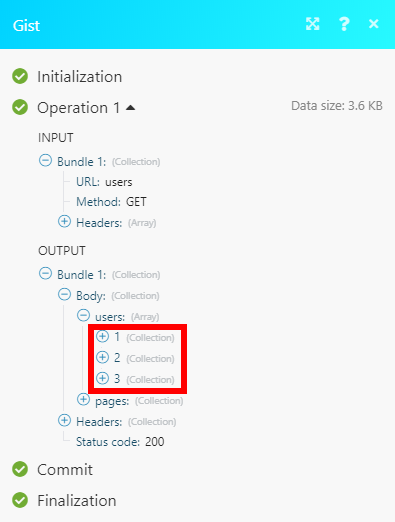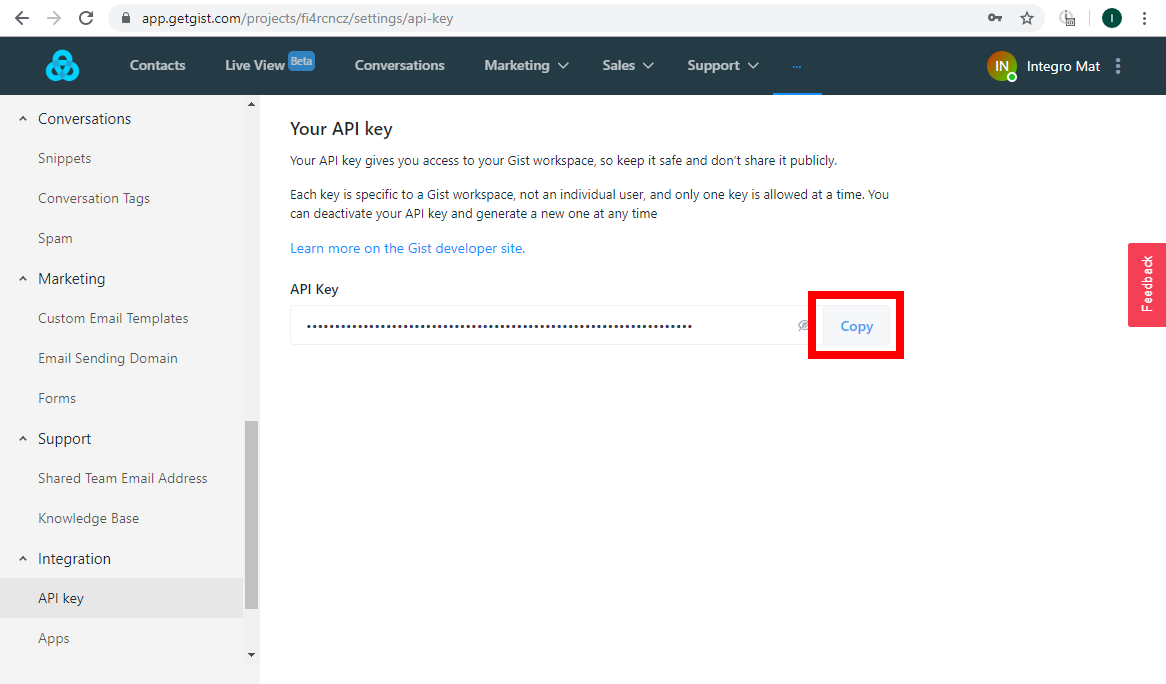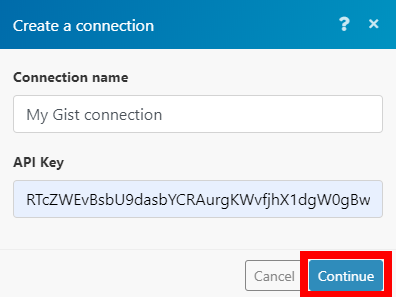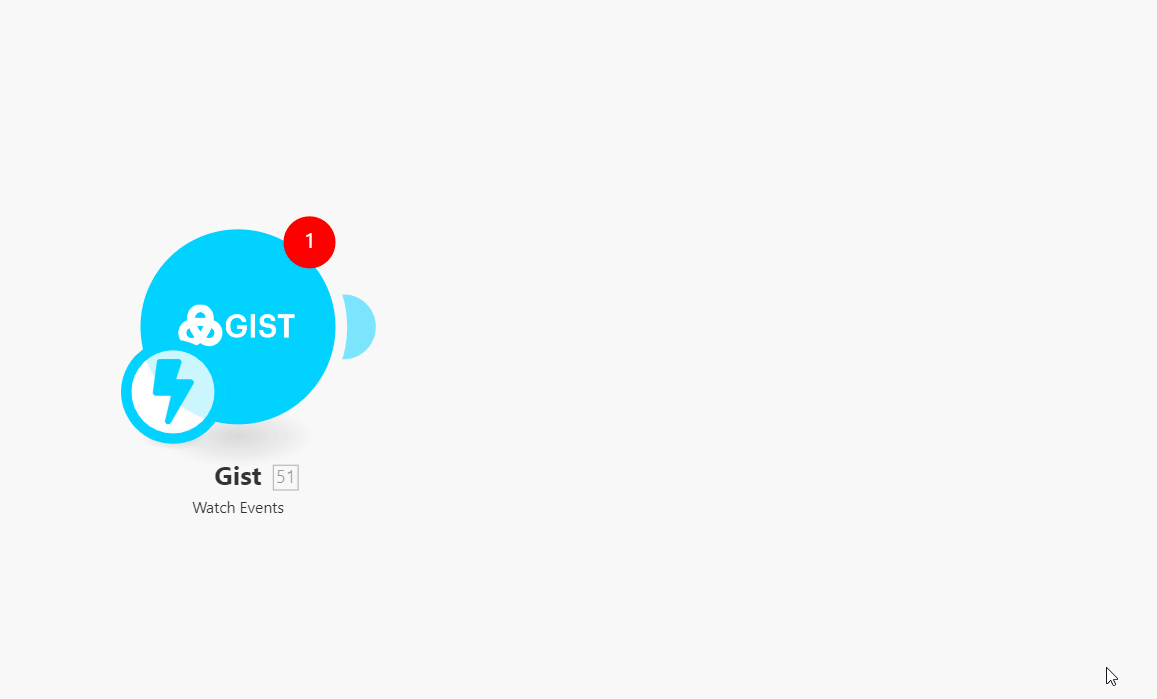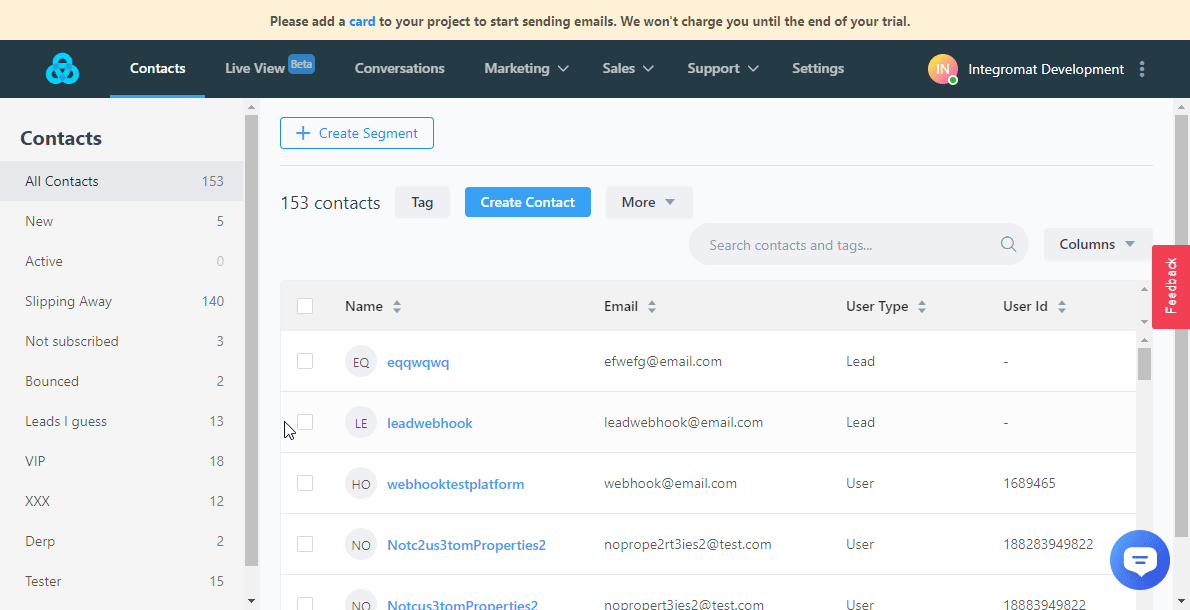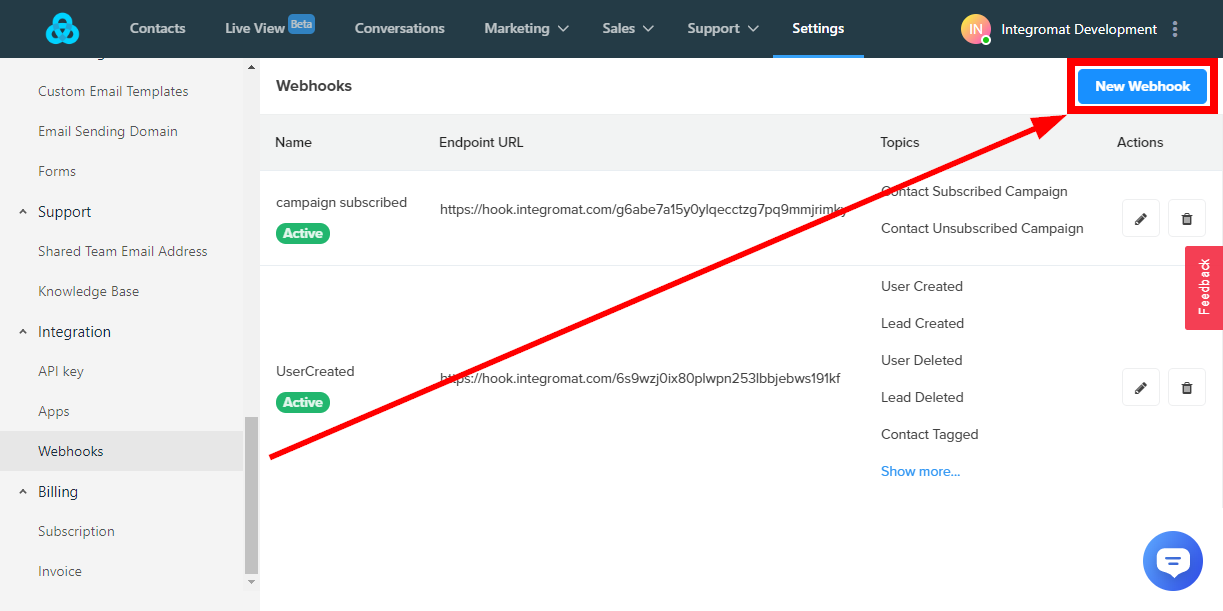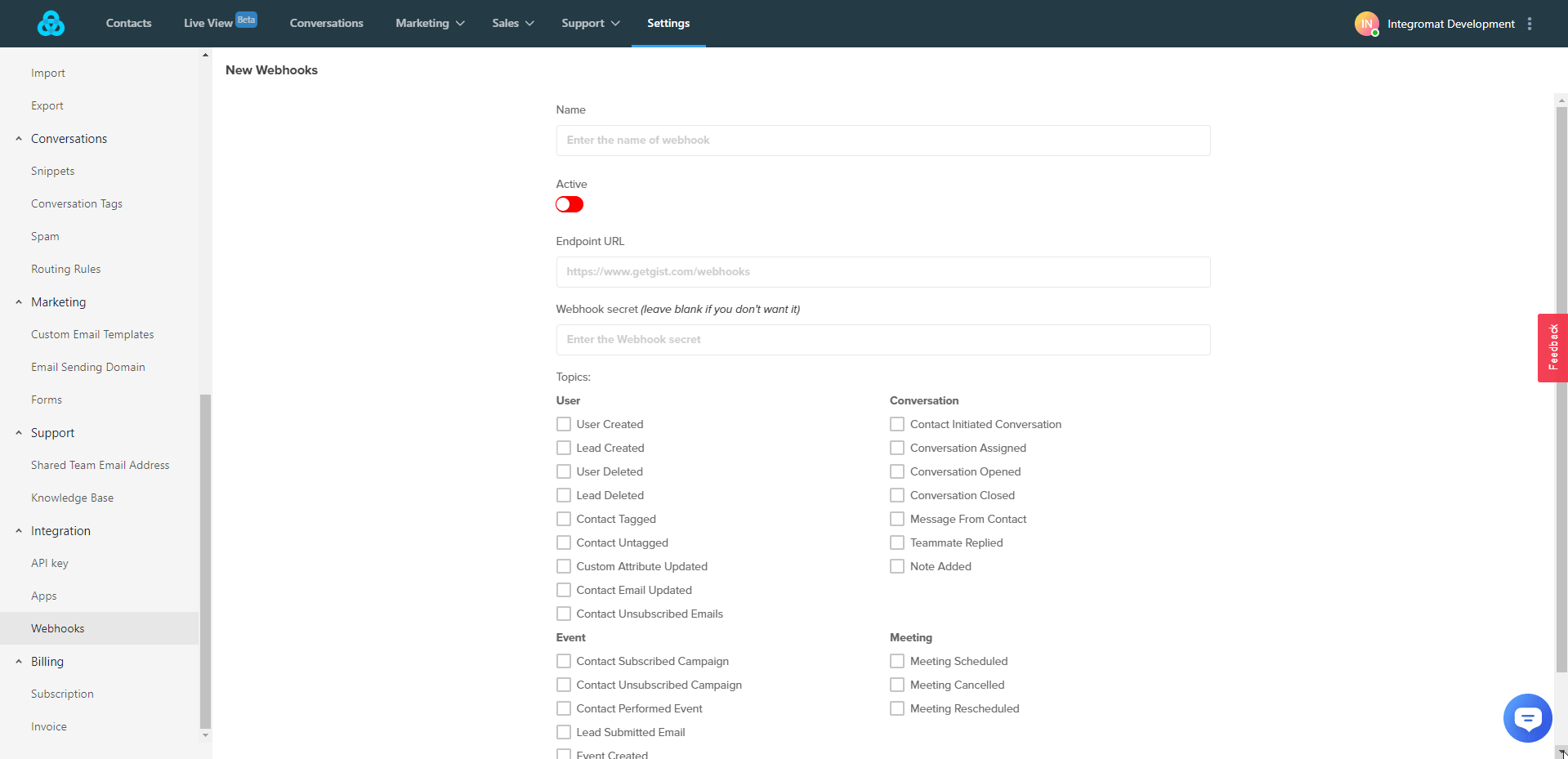| Active with remarks |
|---|
| This application needs additional settings. Please follow the documentation below to create your own connectionUnique, active service acces point to a network. There are different types of connections (API key, Oauth…). More. |
The Gist modulesThe module is an application or tool within the Boost.space system. The entire system is built on this concept of modularity. (module - Contacts) More allow you to create, update, list, and delete usersCan use the system on a limited basis based on the rights assigned by the admin. More, leads, tags, segments, or campaigns in your Gist account.
Prerequisites
-
A Gist account
In order to use Gist with Boost.spaceCentralization and synchronization platform, where you can organize and manage your data. More IntegratorPart of the Boost.space system, where you can create your connections and automate your processes. More, it is necessary to have a Gist account. If you do not have one, you can create a Gist account at app.getgist.com/signup.
![[Note]](https://docs.boost.space/wp-content/themes/bsdocs/docs-parser/HTML/css/image/note.png) |
Note |
|---|---|
|
The moduleThe module is an application or tool within the Boost.space system. The entire system is built on this concept of modularity. (module - Contacts) More dialog fields that are displayed in bold (in the Boost.space Integrator scenarioA specific connection between applications in which data can be transferred. Two types of scenarios: active/inactive. More, not in this documentation article) are mandatory! |
To connect your Gist account to Boost.space Integrator you need to obtain the API Key from your Gist account.
-
Log in to your Gist account.
-
Go to Settings > API key.
-
Click on the Copy button to copy the API Key to your clipboard.
-
Go to Boost.space Integrator and open the Gist module’s Create a connection dialog.
-
Enter the API Key to the respective field and click the Continue button to establish the connection.
TriggersEvery scenario has a trigger, an event that starts your scenario. A scenario must have a trigger. There can only be one trigger for each scenario. When you create a new scenario, the first module you choose is your trigger for that scenario. Create a trigger by clicking on the empty module of a newly created scenario or moving the... when specified events are performed.
![[Note]](https://docs.boost.space/wp-content/themes/bsdocs/docs-parser/HTML/css/image/note.png) |
Note |
|---|---|
|
The module functionality is available only for users who have subscribed to the Gist PRO planCombination of a license (enabled features) and tier (numeric limits) and a subscription period (monthly / yearly).. |
|
WebhookA webhook is a way for an app to send real-time information to a specific URL in response to certain events or triggers. name |
Enter the name for the webhook. E.g. Meeting Scheduled. |
|
Connection |
Establish a connection to your Gist account. |
-
Go to Boost.space Integrator and open the Gist Watch Events module’s settings.
-
Create a Webhook and copy the providedwebhook URL.
-
Log in to your Gist account.
-
Go to Settings > WebhooksA webhook is a way for an app to send real-time information to a specific URL in response to certain events or triggers..
-
Click on the New Webhook button.
-
Enter a name for the webhook. E.g. UserCan use the system on a limited basis based on the rights assigned by the admin. More Created.
-
Switch on the Active button.
-
Enter the webhook URL you have copied in step 2 above to the Endpoint URL field.
-
Select the event(s) that will triggerEvery scenario has a trigger, an event that starts your scenario. A scenario must have a trigger. There can only be one trigger for each scenario. When you create a new scenario, the first module you choose is your trigger for that scenario. Create a trigger by clicking on the empty module of a newly created scenario or moving the... the Gist Watch Events module in Boost.space Integrator and click the Save button.
Now, when a user is created, the Watch Events module in Boost.space Integrator is triggered.
Creates a new user.
|
Connection |
|
|
Email Address |
Enter the new user’s email address. |
|
User ID |
Enter the User ID of your choice. Must be a number. |
|
Name |
Enter the user’s full name. |
|
Phone |
Enter the user’s contact phone number. |
|
Last Seen IP Address |
Enter the last IP address the user visited your website from. |
|
Last Seen User Agent |
Enter the last user agent the user was seen using. |
|
Unsubscribe from Emails |
Select the Yes option if the user has unsubscribed from emails. |
|
Tags |
Add tags to the user. |
|
Custom Properties |
Add custom properties for the new user. You can choose among boolean, date, email, whole number, text, or URL. |
Updates user details.
|
Connection |
|
|
Internal ID or user ID or email |
Select whether you want to specify the user by Internal ID, User ID, or email.Then select or map the value in the respective field below. |
Please find the descriptions of the fields in the Create User section above.
Retrieves user details.
|
Connection |
|
|
Internal ID or user ID or email |
Select whether you want to specify the user by Internal ID, User ID, or email. |
|
Internal ID/User ID/Email |
Select or map the user you want to retrieve details about. |
Retrieves all users in your account based on filter settings.
|
Connection |
|
|
Limit |
Set the maximum number of users Boost.space Integrator will return during one execution cycleA cycle is the operation and commit/rollback phases of scenario execution. A scenario may have one or more cycles (one is the default).. |
|
Filter By |
Select whether you want to filter results by Segment ID, Tag ID, or created since and select or map the value in the respective field. |
|
StatusCreate statuses for each module separately to create an ideal environment for efficient and consistent work. More Filtering |
Select the status you want to filter returned users by. |
|
Sorting |
Select whether to sort results by created at, last seen at, signed up at, or updated at the property. |
|
Sorting Order |
Select whether to sort results in ascending or descending order. Default: descending. |
Deletes a user.
|
Connection |
|
|
Internal ID or user ID or email |
Select whether you want to specify the user you want to delete by Internal ID, User ID, or email. |
|
Internal ID/User ID/Email |
Select or map the user you want to delete. |
Creates a new lead.
|
Connection |
|
|
Email Address |
Enter the new lead’s email address. |
|
Name |
Enter the lead’s name. |
|
Phone |
Enter the lead’s contact phone number. |
|
Last Seen IP Address |
Enter the last IP address the lead visited your website from. |
|
Last Seen User Agent |
Enter the last user agent the lead was seen using. |
|
Unsubscribe from Emails |
Select the Yes option if the lead has unsubscribed from emails. |
|
Tags |
Add tags to the lead. |
|
Custom Properties |
Add custom properties for the new lead. You can choose among boolean, date, email, whole number, text, or URL. |
Updates lead details.
|
Connection |
|
|
|
Select the email address of the lead you want to update. |
Please find the descriptions of the fields in the Create Lead section above.
Retrieves lead details.
|
Connection |
|
|
Internal ID or email |
Select whether you want to specify the user by Internal ID or email. |
|
Internal ID/Email |
Select or map the lead you want to retrieve details about. |
Retrieves all leads in your account based on filter settings.
|
Connection |
|
|
Limit |
Set the maximum number of leads Boost.space Integrator will return during one execution cycle. |
|
Filter By |
Select whether you want to filter leads by segment ID, tag ID, or created since and select or map the value in the respective field. |
|
Status Filtering |
Select the status you want to filter returned leads by. |
|
Sorting |
Select whether to sort results by created at, last seen at, signed up at, or updated at the property. |
|
Sorting Order |
Select whether to sort results in ascending or descending order. Default: descending. |
Deletes a lead.
|
Connection |
|
|
Internal ID or email |
Select whether you want to specify the lead by Internal ID, or email. |
|
Internal ID/Email |
Select or map the lead you want to delete. |
Creates a tag in your Gist account.
|
Connection |
||||
|
Tag Name |
Enter the name for the tag. White spacesSubunits are created within modules to maintain organization and clarity, even with large amounts of data. More and punctuation are allowed.
|
Changes a tag name.
|
Connection |
||||
|
Tag ID |
Select the tag or map the ID of the tag you want to update. |
|||
|
Tag Name |
Enter the new name for the tag. White spaces and punctuation are allowed.
|
Allows you to add a tag to users and/or leads.
|
Connection |
||||
|
Tag Name |
Select the tag you want to assign to users/leads. If the tag does not exist, it will be created. |
|||
|
Users |
Add the users you want to tag.
Untag Select the Yes option to remove the tag from the user. Internal ID/Email/User ID At least one of the fields must be filled in order to specify the user you want to tag. |
|||
|
Leads |
Add leads you want to tag.
Untag Select the Yes option to remove the tag from the lead. Internal ID/Email/User ID At least one of the fields must be filled in order to specify the lead you want to tag. |
Retrieves all tags in your Gist account.
|
Connection |
|
|
Limit |
Set the maximum number of tags Boost.space Integrator will return during one execution cycle. |
Deletes a tag.
|
Connection |
|
|
Tag ID |
Map or select the tag you want to delete. |
Returns a segment.
|
Connection |
|
|
Segment ID |
Map or select the segment you want to retrieve |
|
Include Count |
If the Yes option is selected, the module returns also the number of users in the segment. |
Returns all segments in your account.
|
Connection |
|
|
Limit |
Set the maximum number of segments Boost.space Integrator will return during one execution cycle. |
|
Include Count |
If the Yes option is selected, the module returns also the number of users in the segment. |
Retrieves campaign details.
|
Connection |
|
|
Campaign ID |
Map or select the campaign you want to retrieve details about. |
Returns all campaigns in your account.
|
Connection |
|
|
Limit |
Set the maximum number of campaigns Boost.space Integrator will return during one execution cycle. |
Creates a new tracked event.
|
Connection |
|
|
Event Name |
Enter the tracked event of the user/lead that occurred. Case insensitive. Periods (.) and dollars ($) in event names are replaced with hyphens. e.g., ‘completed.order’ will be stored as ‘completed-order’. |
|
User or Lead |
Select whether the event belongs to the user or lead. Internal ID or user ID or email Select whether you want to specify the user by internal ID, user ID, or email.Then select or map the value in the respective field below. |
|
Properties |
Add the custom properties about the event. |
Returns all tracked events in your account.
|
Connection |
|
|
Limit |
Set the maximum number of tracked events Boost.space Integrator will return during one execution cycle. |
Allows you to perform a custom API call.
|
Connection |
||||
|
URL |
Enter a path relative to
|
|||
|
Method |
Select the HTTP method you want to use: GET to retrieve information for an entry. POST to create a new entry. PUT to update/replace an existing entry. PATCH to make a partial entry update. DELETE to delete an entry. |
|||
|
Headers |
Enter the desired request headers. You don’t have to add authorization headers; we already did that for you. |
|||
|
Query String |
Enter the request query string. |
|||
|
Body |
Enter the body content for your API call. |
The following API call returns all users:

Matches of the search can be found in the module’s Output under BundleA bundle is a chunk of data and the basic unit for use with modules. A bundle consists of items, similar to how a bag may contain separate, individual items. More > Body > users.
In our example, 3 users were returned:
